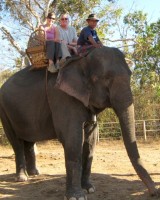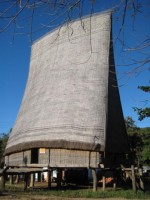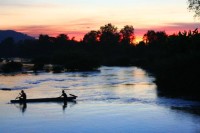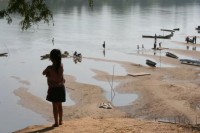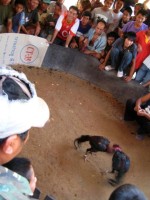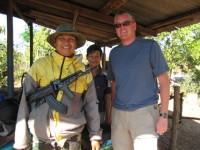Sun 2 Mar 2008
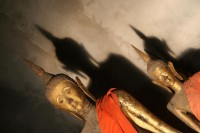
As the true jewel in Laos’s crown of tourist attractions, Luang Prabang–with a population of only 26,000–is not a big city. Rather, it’s a small town with a lot to offer the ever-increasing number of tourists who come to wander its idyllic streets, dine in its French-influenced cafes and soak up its incredibly contagious relaxed attitude. After five days of doing just that, I find that I can sum up our time in Luang Prabang by recalling three great experiences and one that I’m still worrying about.
First, the good stuff…
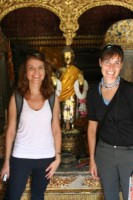
As we meandered through Luang Prabang’s neighborhoods, we came across temple after temple that housed both ancient relics and young novice monks eager to practice their English with passers-by.  Like so many churches in small-town America, the temples felt very much like the center of the town’s community life. Wat Xieng Thong, a temple just down the street from our guesthouse, was celebrating a once-a-year festival while we were there.  We were lucky to witness the temple’s vibrant religious community performing ceremonies on their own behalf, rather than–as we’ve seen elsewhere–because tourists expected them to do so.
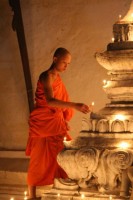
One day, Derek, Dana–my good friend who joined us on our travels for a couple of weeks–and I took at boat down the Mekong to the Pak Ou Caves. Docking on the riverbank, we found two caves situated one on top of the other in a limestone cliff. Both were crammed with Buddha images of all sizes and styles, and a few locals were on hand to pay their respects to these unique additions to the natural world.
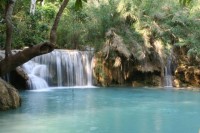
The next day, we all hopped aboard a tuk-tuk and rode an hour through the Laos countryside to the Tat Kuang Si waterfalls. What an incredible surprise! You know those glossy brochures that advertise tropical getaways? They usually feature a happy couple laughing under a waterfall while standing in a turquoise pool of water, surrounded by tropical foliage and brightly colored flowers. Well, I’d say that there is a fairly strong chance that those pictures were taken at these waterfalls. They were stunning and, because we arrived just as the park that houses them was opening, we had them nearly all to ourselves. A random but fantastic bonus were the caged bears and tiger that greeted us at the park’s entrance. Rescued from poachers, they now live out their days in large habitats under the protective watch of the park staff.
And now, the worrisome part…
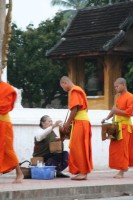
On our last morning in Luang Prabang, we woke up early to witness a ritual that surely has been taking place for as long as the townspeople can remember. Every morning, just after 6:00 a.m., hundreds of monks line up and walk down the main street, collecting offerings of food that will serve as their meals for the day. In their saffron-colored robes under the early-morning sky, the monks are a sight that most everyone would want to see. And that’s just the problem: everyone does. Tourists piled off of buses and onto plastic stools placed along the road for them by enterprising tour operators. With their flashing cameras and their frantic efforts to capture every move that the monks made, they would have put the American paparazzi to shame. And I admit: we all did our part to add to the madness. We guiltily snapped pictures and took videos alongside the rest of the onlookers, only adding to the sense that the monks had way too much in common with the caged animals we saw at the falls–lovely to look at and permanently on display. And therein, I suppose, lies one of the biggest paradoxes of independent travel: we all want to witness (and photograph) unique, authentic occasions. We just wish that everyone there to do the same would stop ruining the experience for us.
[embedplusvideo height=”350″ width=”450″ editlink=”http://bit.ly/1AczkgF” standard=”http://www.youtube.com/v/nAQrT43I2mY?fs=1″ vars=”ytid=nAQrT43I2mY&width=450&height=350&start=&stop=&rs=w&hd=0&autoplay=0&react=1&chapters=¬es=” id=”ep2128″ /]
[embedplusvideo height=”350″ width=”450″ editlink=”http://bit.ly/1AcA2dN” standard=”http://www.youtube.com/v/6UQx84XRAuo?fs=1″ vars=”ytid=6UQx84XRAuo&width=450&height=350&start=&stop=&rs=w&hd=0&autoplay=0&react=1&chapters=¬es=” id=”ep3084″ /]

